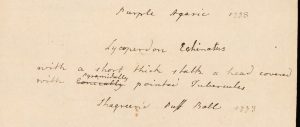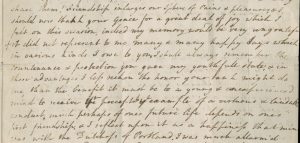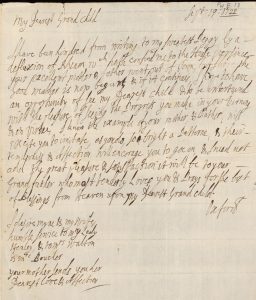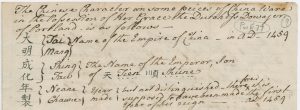June 21, 2022, by Kathryn Summerwill
Fungi and friendship: Margaret Cavendish-Bentinck, 2nd Duchess of Portland
This is a guest post written by UoN MA English Literature student Eve Campbell.
Deciphering and researching the letters of Margaret Cavendish-Bentinck, 2nd Duchess of Portland (1715-1785), has been an insightful and rewarding experience and has allowed me to learn about different roles at Manuscripts and Special Collections. My placement required me to read through the collection of letters sent from and to the duchess. Once I had navigated the handwriting, I wrote content descriptions of the letters which included naming any people or places who were mentioned in the letters. I also got to investigate some of the correspondents in detail, especially Elizabeth Montagu and John Lightfoot whose letters make up a large proportion of the collection.
John Lightfoot

List of fungi in the handwriting of Margaret Cavendish-Bentinck, 2nd Duchess of Portland (Pw E 63/2)
John Lightfoot was a naturalist who became the duchess’s chaplain in 1767. Lightfoot and the duchess shared a passion for nature and their correspondence show how they devoted their time to researching, drawing and identifying plants. In Pw E 20, Lightfoot identifies fungi for the duchess. It is clear how knowledgeable he is about the subject as he often quotes the Latin names of the plants as well as giving detailed descriptions of their properties. The Duchess reciprocates Lightfoot’s interest as some of her notes, such as Pw E 63/2, show how she provided considered descriptions of the plants found on her estate at Bulstrode, Buckinghamshire.
Elizabeth Montagu

Detail from letter from Elizabeth Montagu to the 2nd Duchess of Portland, on the subject of friendship, 1751 (Pw E 32)
Elizabeth Montagu (1718-1800) was the most interesting correspondent to research. Montagu and the duchess’s relationship was turbulent at times and it was reported that an incident caused them to cease communication for a number of years. Looking at Montagu’s letters allowed me to learn about social etiquette and social hierarchies in the 18th century. Montagu admits in Pw E 32 that being friends with the duchess had increased her social status. Montagu’s letters also made me hone another skill as most of her letters were undated. I had to use sources such as the Oxford Dictionary of National Biography [UoN members are automatically subscribed] and The National Archives’ Discovery catalogue to research birth and death records, marriage dates etc that might allow me to estimate a date the letters must have been written. Montagu was a fruitful resource for estimating the dates of the letters as she varied how she signed off her letters between her maiden name (Robinson) and her married name (Montagu) which allowed me to get a closer estimate of the dates.
Family and other interests
The letters allowed me to explore family dynamics, as there were letters from grandchildren, children, parents and grandparents. Pw E 13 is a letter from the duchess’s grandfather, Robert Harley, 1st Earl of Oxford (1661-1724), sent in 1722 when Margaret was seven years old, in which you see a very intimate relationship between the pair. The most touching aspect is Harley’s nickname for his granddaughter, ‘sweetest Peggy’. This collection provides a real insight into the Portland family and that is best seen through the letters sent by the family.
As well as finding out about family dynamics, the letters allow for insights into the duchess’s interests. Aside from her interest in plants, which is mentioned above, the duchess had an interest in history. This is evident in her notebook, Pw E 72, which contains vast notes on various historical figures, places and objects. One of the most visually pleasing letters, Pw E 77 is a note which describes pieces of China ware in her collection. The note contains some of the Chinese symbols on the pieces with descriptions of their history.
I thoroughly enjoyed my experience working with the letters, and learnt a lot from the contents as well as from the process. I was able to learn how to carefully handle the letters, how to catalogue the letters and more about how the letters are being preserved by Manuscripts and Special Collections.
If this has inspired you, click here to find out more about the Portland collections. You can email us mss.library@nottingham.ac.uk to make an appointment to visit the Reading Room or ask about volunteering here. Or, follow us @mssUniNott on Twitter, Instagram and our newsletter for more about our collections and placements more generally.
No comments yet, fill out a comment to be the first



Leave a Reply